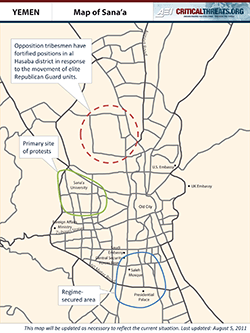 |
There is evidence that separate armed opposition groups are contesting control of territory in south Yemen. Yemeni security forces are attempting to reassert state control in Abyan and in Arhab district in Sana’a.
Rival militant groups fought in Jaar in Abyan governorate. Abdul Latif al Sayyed had demanded that al Qaeda militants leave the town; local al Qaeda leader Abu Ali Hadrami refused. At least four militants were killed and seven others injured in the ensuing clashes. Abdul Latif al Sayyed is a supporter of the Southern Movement.
Fierce fighting occurred in Arhab district of Sana’a. Twenty-three opposition tribesmen were killed in clashes with elite Republican Guard forces. The Yemen state news agency reported that tribesmen have accused U.S.-designated terrorist Sheikh Abdul Majid al Zindani of sending over 300 fighters into Arhab and Nihm districts in Sana’a.
A bomb exploded near an al Houthi-held government administration complex in al Jawf. The blast targeted a meeting of al Houthi leaders in al Matama on Sunday. The al Houthis called the attack a “US intelligence-style criminal act” intended to spark sectarian fighting in Yemen. No evidence was offered supporting the claim. The al Houthis and the Islamist Islah (Reform) party had signed a ceasefire two days prior to the attack.
New evidence may link Iran to al Qaeda in the Arabian Peninsula. U.S. officials reported that the Indian Navy intercepted the MV Nafis-I near Mumbai after tracking the ship for a number of days. The ship was allegedly en route to Yemen from Iran and U.S. officials believed it was bringing supplies to al Qaeda in the Arabian Peninsula. The Indian Navy found primarily food and supplies aboard the ship, alongside some weapons (AK-47s and a pistol).
A resolution to the political crisis in the capital will not end the fragmentation of the Yemeni state, which remains at risk of a broader armed conflict. The current situation has increased al Qaeda's operating space in Yemen.
